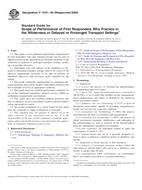Potřebujeme váš souhlas k využití jednotlivých dat, aby se vám mimo jiné mohly ukazovat informace týkající se vašich zájmů. Souhlas udělíte kliknutím na tlačítko „OK“.
ASTM F1258-95(2014)
Standard Practice for Emergency Medical Dispatch
Automaticky přeložený název:
Standardní praktiky pro rychlou lékařskou Dispatch
NORMA vydána dne 1.6.2014
Informace o normě:
Označení normy: ASTM F1258-95(2014)
Poznámka: NEPLATNÁ
Datum vydání normy: 1.6.2014
Kód zboží: NS-49658
Počet stran: 8
Přibližná hmotnost: 24 g (0.05 liber)
Země: Americká technická norma
Kategorie: Technické normy ASTM
Kategorie - podobné normy:
Anotace textu normy ASTM F1258-95(2014) :
Keywords:
communications, dispatch, emergency medical dispatch, ICS Number Code 11.160 (First aid),13.320 (Alarm and warning systems)
Doplňující informace
| Significance and Use | ||||||||
|
5.1 This practice is intended to promote the use of trained telecommunicators in the role of emergency medical dispatcher. It defines the basic skills and medical knowledge to permit understanding and resolution of the problems that constitute their daily routine. To use trained telecommunicators fully as functioning members of the emergency medical team, it is deemed necessary to upgrade the telecommunicators' training by the addition of the concept of emergency medical dispatch priorities. 5.2 All agencies or individuals who routinely accept calls for emergency medical assistance from the public and dispatch emergency medical personnel shall have in effect an emergency medical dispatcher program in accordance with this practice. The program shall include medical direction and oversight and an emergency medical dispatch priority reference system. 5.3 The successful use of the EMD concept depends on the medical community's awareness of the “prearrival” state of EMS affairs and their willingness to provide medical direction in dispatch. 5.4 This practice may assist in overcoming some of the misconceptions regarding emergency medical dispatching. These include the uncontrollable nature of the caller's hysteria, lack of time of the dispatcher, potential danger and liability to the EMD, lack of recognition of the benefits of dispatch prearrival instructions, and misconceptions that red lights, siren, and maximal response are always necessary. 5.5 The EMD is the member of the EMS response team with the broadest view of the entire emergency system's current status and capabilities. The EMD has immediate lifesaving capability in converting the caller into an effective first responder. This practice recognizes the EMD's role as including: 5.5.1 Interrogation techniques, 5.5.2 Triage decisions, 5.5.3 Information transmission, 5.5.4 Telephone medical intervention, and 5.5.5 Logistics and resource coordination during the event. 5.6 For the EMD, this practice supersedes any other EMSS standards under which an individual may be qualified, such as Practice F1031. It is not the role of the EMD to generate a specific diagnosis but rather to elicit accurately a finite body of information, assign the appropriate response, and to communicate clearly among persons and units involved in the response. The protocols for inquiry, response, and resource coordination are essential and must not be modified based on an individual's possible experiences as a responder. 5.7 As an initial contact with the EMS system, the EMD is subject to questioning of actions as they relate to medical practice. This practice may be used by agencies as a recognized baseline for EMD training, practice, and organization and is intended to supplant de facto standards that exist in some areas. This practice will assist in developing sound EMD programs that will reduce the need and potential for legal action and provide a common set of expectations for performance. 5.8 It will bring more accurate information into the dispatch office by way of appropriate understanding of the medical condition and therefore better interrogation, caller intervention, and decision-making. It allows for preplanned responses, safer responses (fewer units responding with lights and siren), fuel and energy savings (smaller units and fewer units used when possible), and may save advanced lifesupport resources for true advanced life-support emergencies when a tiered-level response is available. |
||||||||
| 1. Scope | ||||||||
|
1.1 This practice covers the definition of responsibilities, knowledge, practices, and organizational support required to implement, perform, and manage effectively the emergency medical dispatch function. 1.2 This practice is useful for planning and evaluating the training, implementation, and organizational support to satisfy the functional needs of emergency medical dispatching. 1.3 This standard does not purport to address all of the safety concerns, if any, associated with its use. It is the responsibility of the user of this standard to establish appropriate safety and health practices and determine the applicability of regulatory limitations prior to use. |
||||||||
| 2. Referenced Documents | ||||||||
|
Podobné normy:
Historická
1.2.2007
Historická
1.2.2007
Historická
1.2.2007
Historická
1.6.2014
Historická
1.3.2009
Historická
1.2.2007
Odebírejte informace o nově vydaných normách ZDARMA:
Chcete pravidelně odebírat informace o nově vycházejících normách z celého světa a to zcela zdarma?
Přihlašte se k odběru. Vše je velice jednoduché a absolutně ZDARMA.
Na výběr máte vydavatele z celého světa.



 ASTM F1557-94(2007)..
ASTM F1557-94(2007).. ASTM F1558-94(2007)..
ASTM F1558-94(2007).. ASTM F1559-94(2007)..
ASTM F1559-94(2007).. ASTM F1560-00(2014)..
ASTM F1560-00(2014).. ASTM F1616-95(2009)..
ASTM F1616-95(2009).. ASTM F1629-95(2007)..
ASTM F1629-95(2007)..
 Cookies
Cookies
